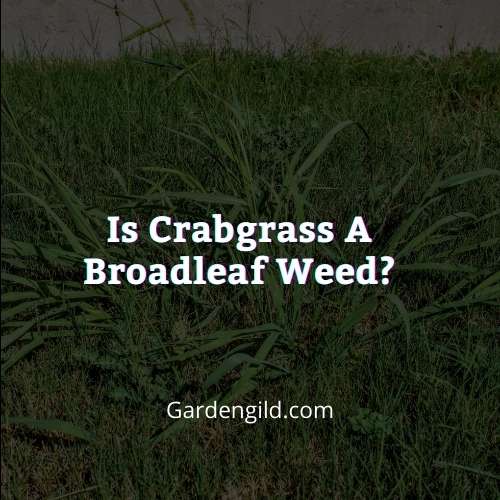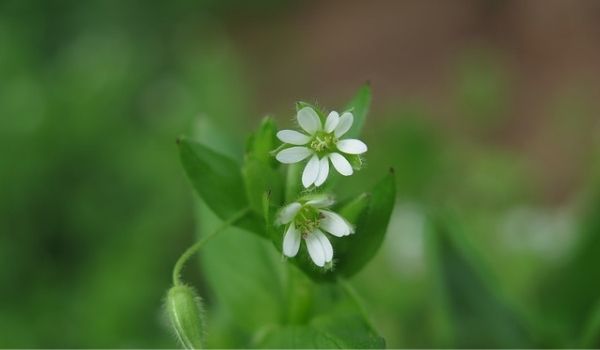Crabgrass is a grass, most combined herbicide and yard compost items, known as weed and feed manures, will not be able to destroy it. These items usually incorporate specific herbicides that kill broadleaf weeds.
Such as dandelions and other normal yard weeds that keep grasses safe. However, effectively developing crabgrass in your yard calls for specific, post-rising herbicides, like ‘All-In-One Lawn Weed Killer’ or ‘Herbicide Kills,’ that kill crabgrass and leave your grass immaculate.
Those coarse, ugly weeds appear to live and spread for eternity when crabgrass begins in your yard.
However, unlike yard weeds that do live quite a long while, crabgrass plants just live a solitary year. What they do in that year, nonetheless, has dependable ramifications for your yard.

What are the examples of Broadleaf weed?
Broadleaf weeds are undesirable intense plants that might fill in yards, nurseries, or lawns. They are much easier to spot when developing among grasses. They increase easily and can be exceptionally difficult to annihilate.
These can arise every year, biennially or perpetually, making predictable administration troublesome. In addition, enduring weeds are frequently undeniably challenging to control as they recover quicker than they can be destroyed.
Broadleaf weeds, as their name recommends, frequently have wide leaves and develop from a stem. Most broadleaf weeds foster groups of blooms or single blossoms as they grow that can be viewed as unwanted. In addition, the foundations of most broadleaf weeds are sinewy.
The roots can be meager, an enormous taproot, or a blend. Numerous broadleaf weeds spread through their seeds and rhizomes, albeit some lone spread through seeds.
Types of broadleaf weeds
1. Chickweed:

It’s a yearly and perpetual blossoming plant in the family Caryophyllaceae. It is local to Eurasia and naturalized all through the world.
This species is utilized as a natural cooling cure and developed as a vegetable yield and ground cover for human and poultry utilization.
It is now called normal chickweed to recognize it from different plants called chickweed. Other names are chickenwort, craches, maruns, and winter weed.
The plant sprouts in harvest time or pre-spring, then, at that point, shapes huge mats of foliage.
2. Clover:

They are yearly & biennial enduring herbaceous plants, regularly growing up to 30 cm tall. The leaves are trifoliate, monofoil, bifoil, etcetera. Thick spikes of various colors; tiny in size, not many cultivated cases are encased in the calyx.
Other firmly related genera regularly called clovers incorporate Melilotus and Medicago.
Can I apply crabgrass preventer, weed, and feed at the same time?
Yes, all these are effective together because they need to be watered under the soil. Applying both immediately and watering them in feeds your grass and prevents weed seeds from growing.
This implies that more of your compost will take care of your yard, and weeds will take fewer supplements. In addition, buying one of these blend items is more affordable and convenient than purchasing two items. Besides, you just need to spread one item, decreasing your work time.
What is the best weed killer for crabgrass?
The ideal approach to kill effectively developing crabgrass in your yard is applying a specific executioner containing Quinclorac. It will eliminate the weed without killing yard grasses. ‘Syngenta Tenacity Turf Herbicide 2-in1 preventer + killer’.
This is the absolute best crabgrass executioner and preventer when utilized together.
Functioning accordingly, it will not kill grass in your yard, so you can apply it to destroy grass weeds from developing, or even a while later in the late spring to kill completely mature weeds.
Surfactant is fundamentally a cover or pastes which, when blended in with persistence, will adhere the herbicide to the grass leaves when applied.
Tenacity will drench into the dirt and become less effective. This item makes it simpler to perceive what you have applied. It’s discretionary; however, the minimal expense to add it in is justified. Make sure to add all of the chemicals to get the best results.
How to kill crabgrass and prevent it from returning?
Crabgrass is a serious headache, and no one can feel this pain without gardeners. Crabgrass spreads rapidly during the warm late spring months.
Among midsummer and late-summer, every crabgrass plant produces a large number of seeds.

Mainly it kills the plants; however, the seeds stay lethargic through the colder time of year. Then, at the point when the ground temperature heats up, the seeds start to develop. The way to control it is by ensuring the seeds can’t sprout.
If you just have a couple of crabgrass in your yard, you can destroy them with a handy item. ‘Syngenta Tenacity Turf Herbicide 2-in1 preventer + killer’. When utilized as coordinated, this kills weeds, including crabgrass, down to the root without ruining your yard.
Of course, crabgrass can also be; however it ought to be done from the get-go in the season before the plants can deliver seeds.
It is far simpler to stop crabgrass in the spring before it becomes an annoyance in the mid-year. In addition, crabgrass seeds can begin to grow in the spring once the dirt ranges 55 °F, so crabgrass preventers ought to be applied right on time to mid-spring before the crabgrass begins to create.
In case you’re additionally managing broadleaf weeds. In addition to the fact that it prevents crabgrass for a very long time and feeds your grass, yet it likewise kills weeds like dandelion and clover.
Weeds are better adjusted to unfavorable developing conditions than most yard grasses. Shallow, incessant watering empowers external root development, making the grass endure during warm and dry spell times.
That sort of pressure can prompt dainty fixes, and uncovered spots will exploit. Water yards profoundly and rarely urge your grass to foster further roots, which can become thicker to assist swarm with trip weeds.
A thick, full grass sometimes contains a lot of crabgrass. Taking care of your yard routinely, every 6 to about two months, during the developing season with grass manure helps your yard stay thick and lavish, making it less inviting to weeds by passing on little space for them to develop.
There’s no alternative to taking care of your lawn; you always have to keep it fresh and healthy.
people also ask
1. When is the best time to apply crabgrass pre-emergent?
To keep crabgrass from developing in your yard, apply a pre-emergent at the end of the winter since this is the point at which the weed will begin to grow in your grass.
Any time between late March and early April are the ideal occasions to put down a pre-emergent herbicide.
2. Why is crabgrass so bad?
It’s not just bad; it’s worse. It not only occupies your lawn but generates seeds secretly. These generated seeds will grow later on, even if you cut off the crabgrass.
Dealing with these types of hassles is tough and challenging for you and your lawn. So it’s mandatory to destroy all crabgrass as well as its seeds.
3. Should you pull up dead crabgrass?
Crabgrass takes up space, and even after it’s dead, you’re still not sure that the seeds have died as well.
So if there are seeds under the dead crabgrass, it’s going to be a huge mess. So it’s better to cut off and destroy it in every way possible.
Read also:
Is crabgrass a broadleaf weed? Final thoughts
Crabgrass is a broadleaf weed. This weed is critical for any lawn grass and plants. Crabgrass is known for sucking up vital nutrients from the soil rapidly.
You need to use a crabgrass preventer or killer to get rid of crabgrass from the lawn.
